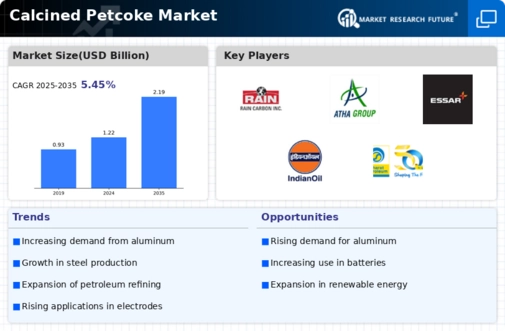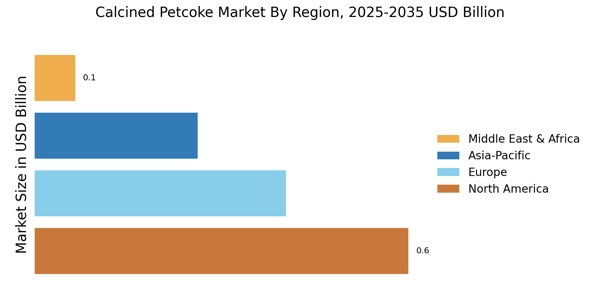Rising Energy Needs
The Calcined Petcoke Market is poised to benefit from the rising energy needs across various sectors. Calcined petcoke is increasingly being utilized in the production of carbon electrodes for the energy sector, particularly in the generation of electricity through coal-fired power plants. As energy consumption continues to escalate, driven by urbanization and industrialization, the demand for calcined petcoke is expected to rise. Current projections suggest that energy demand could increase by approximately 2% annually, which may lead to heightened consumption of calcined petcoke in energy-related applications. This trend indicates that the calcined petcoke market could see substantial growth as energy producers seek efficient and cost-effective materials for their operations.
Expansion of the Steel Industry
The Calcined Petcoke Market is also influenced by the expansion of the steel industry, which relies on calcined petcoke as a key ingredient in the production of steel. Calcined petcoke is utilized in the production of electrodes for electric arc furnaces, which are essential for steel manufacturing. With the increasing demand for steel in construction and infrastructure projects, the steel industry is projected to grow significantly. Reports indicate that the steel production is anticipated to increase by around 3% annually, which could lead to a corresponding rise in the demand for calcined petcoke. This growth in the steel sector is likely to create new opportunities for the calcined petcoke market, as manufacturers seek to secure reliable sources of this critical material.
Technological Innovations in Production
The Calcined Petcoke Market is witnessing advancements in production technologies that enhance efficiency and reduce costs. Innovations such as improved calcination processes and the development of more efficient furnaces are enabling manufacturers to produce higher quality calcined petcoke with lower energy consumption. These technological improvements not only increase the yield of calcined petcoke but also minimize environmental impacts, aligning with sustainability goals. As manufacturers adopt these technologies, the overall production capacity of calcined petcoke is likely to expand, meeting the growing demands from various industries. This evolution in production technology could potentially reshape the calcined petcoke market, making it more competitive and responsive to market needs.
Increasing Demand from Aluminum Industry
The Calcined Petcoke Market is experiencing a notable surge in demand, particularly from the aluminum sector. Calcined petcoke serves as a crucial raw material in the production of aluminum, where it is utilized as anode material in smelting processes. As the aluminum industry continues to expand, driven by applications in automotive, aerospace, and construction, the demand for calcined petcoke is projected to rise. Recent estimates indicate that the aluminum production is expected to grow at a compound annual growth rate of approximately 4% over the next few years, thereby bolstering the calcined petcoke market. This trend suggests that the calcined petcoke market will likely benefit from the aluminum industry's growth trajectory, reinforcing its position as a vital component in aluminum manufacturing.
Regulatory Support for Industrial Growth
The Calcined Petcoke Market is benefiting from regulatory frameworks that support industrial growth and sustainability initiatives. Governments are increasingly implementing policies that encourage the use of calcined petcoke in various applications, particularly in the aluminum and steel industries. These regulations often aim to promote energy efficiency and reduce carbon emissions, which can enhance the attractiveness of calcined petcoke as a material choice. Furthermore, incentives for cleaner production methods may lead to increased investments in calcined petcoke production facilities. As regulatory support continues to evolve, it is likely to create a favorable environment for the calcined petcoke market, fostering growth and innovation in the industry.


















Leave a Comment